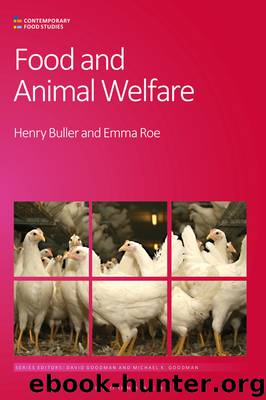Food and Animal Welfare by Buller Henry Roe Emma

Author:Buller, Henry,Roe, Emma
Language: eng
Format: epub
Publisher: Bloomsbury UK
Frame four: Labelling
Many assurance schemes specifying the respect of distinct welfare standards are, to all intents and purposes, ‘invisible’ to conventional shoppers and consumers. A retailer might stipulate on its web pages and corporate social responsibility statement that, for example, no caged eggs are used in its own brand processed food, but there may be little if anything to indicate this on the product itself. Fresh meat may be produced to RSPCA-assured standards but there may be no clue to this at the butcher’s counter. Other schemes and levels of compliance however may be specifically identifiable through on-product labels, statements or packaging styles. If the former are all about selling – or creating confidence in – a brand or retailer identity and its reputational capital, the latter are largely about creating a distinct niche market aimed at specifically concerned consumers. Farm animal welfare is thereby differentially ‘framed’ by food actors through labels and product information. Coming back to Çalışkan and Callon (2010: 12), labels might be understood as ‘so many pre-calculated operations’ constituting the calculative capacities of different agencies. This though endows them with a normativity and intentionality that is not always born out in practice; consumers don’t necessarily read them and are frequently confused by them, particularly when it comes to animal welfare (Schroder and McEachern, 2004; Evans and Miele, 2008). Animal welfare is a peculiar product, in many ways suggestive of what Karpik (2010) refers to as a ‘singularity’, a product defined by a multidimensional, uncertain and incommensurable quality (Hutter, 2011). Such products, he argues, are selected by informed consumers on the basis of these, sometimes elusive, qualities rather than price. To assist them in the making of that selection, various ‘judgement devices’ (which echo Callon and Muniesa’s ‘market devices’) are employed, foremost among which, for our purposes here, are brands and labels. Labels occupy a somewhat dualistic terrain between standardization and distinction (Beregson et al., 2014), between the need to demonstrate conformity and adherence to a set of (often hidden) standards and the need, for the consumers and the retailers, to distinguish themselves and the strength of their engagement. They are shaped by material, regulatory, semiotic, scientific and aesthetic considerations, a coming together of exchange, normalizing and representational practices (Kjellberg and Helgesson, 2007).
As assurance schemes have multiplied, so the debate on labelling has intensified (e.g. www.labellingmatters.org; Farm Animal Welfare Forum, 2011). Food labelling performs different functions for different interests though four principal rationales stand out:
- Labelling enables markets to be segmented and thereby create and justify additional market value for producers/industry/retailers.
- Labelling informs differentiated consumers and enables them to make a choice according to the different selection criteria they have.
- Labelling demonstrates conformity to required rules, shows transparency and establishes due diligence thereby facilitating public surveillance and confidence.
- Labelling/branding encourages customer fidelity.
There is a fifth rationale which we might term the bio-political rationale. Labelling is also a way for governments (and not always just governments) to influence markets and the way consumers make selections about food for what are often multiple sociopolitical and economic reasons.
Download
This site does not store any files on its server. We only index and link to content provided by other sites. Please contact the content providers to delete copyright contents if any and email us, we'll remove relevant links or contents immediately.
Craft Beer for the Homebrewer by Michael Agnew(17942)
Marijuana Grower's Handbook by Ed Rosenthal(3523)
Barkskins by Annie Proulx(3197)
Project Animal Farm: An Accidental Journey into the Secret World of Farming and the Truth About Our Food by Sonia Faruqi(3032)
Red Famine: Stalin's War on Ukraine by Anne Applebaum(2818)
The Plant Messiah by Carlos Magdalena(2760)
0041152001443424520 .pdf by Unknown(2617)
Organic Mushroom Farming and Mycoremediation by Tradd Cotter(2575)
In the Woods by Tana French(2430)
Beer is proof God loves us by Charles W. Bamforth(2262)
7-14 Days by Noah Waters(2259)
The Art of Making Gelato by Morgan Morano(2164)
Reservoir 13 by Jon McGregor(2154)
Meathooked by Marta Zaraska(2151)
Birds, Beasts and Relatives by Gerald Durrell(2141)
Borders by unknow(2123)
The 7 Habits of Highly Effective People: Powerful Lessons in Personal Change (25th Anniversary Edition) by Covey Stephen R(2087)
Between Two Fires by Christopher Buehlman(2060)
The Lean Farm Guide to Growing Vegetables: More In-Depth Lean Techniques for Efficient Organic Production by Ben Hartman(2014)
